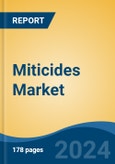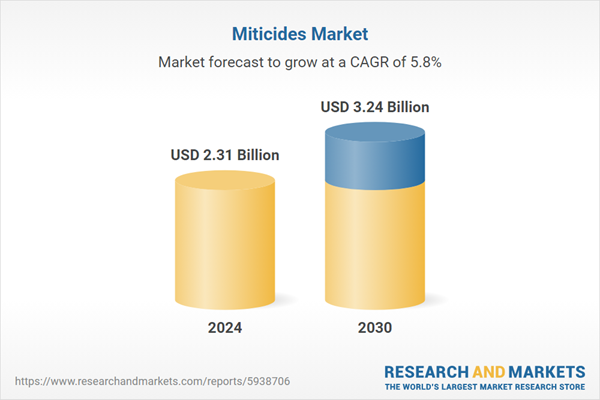Free Webex Call
The Miticides Market was valued at USD 2.31 Billion in 2024, and is expected to reach USD 3.24 Billion by 2030, rising at a CAGR of 5.80%. The Global Miticides Market is a dynamic and vital segment within the broader agricultural chemicals industry, focused on addressing mite-related pest challenges in crop cultivation. This market overview provides a comprehensive understanding of key factors, trends, and dynamics shaping the landscape of miticides on a global scale. Speak directly to the analyst to clarify any post sales queries you may have.
10% Free customizationThis report comes with 10% free customization, enabling you to add data that meets your specific business needs.
The Global Miticides Market continues to evolve, driven by a combination of market drivers, challenges, and transformative trends. The market's future trajectory will be shaped by innovations in technology, regulatory landscapes, and the industry's commitment to sustainability, positioning miticides as pivotal components in ensuring global food security and agricultural sustainability.
Key Market Drivers
Increasing Demand in Agriculture
The Global Miticides Market is witnessing robust growth, propelled significantly by the increasing demand in agriculture. This driver is intricately linked to several key factors contributing to the expansion and sustainability of the market. The foremost factor fueling the demand for miticides is the imperative need for crop protection. Agriculture is the backbone of global food production, and ensuring the health and productivity of crops is paramount. Miticides play a pivotal role in safeguarding crops against the damaging impact of mites, which can lead to reduced yields and compromised quality. As the global population continues to surge, there is an intensified focus on optimizing agricultural practices to meet the escalating demand for food.In tandem with the demand for increased agricultural output, there is a growing recognition of the importance of sustainable and environmentally friendly pest management practices. Integrated Pest Management (IPM) has gained prominence, and miticides are integral to this approach. Farmers are increasingly adopting a holistic strategy that combines biological, cultural, and chemical control methods. Miticides, when used judiciously as part of IPM programs, contribute to the overall health of the agroecosystem.
The digital transformation in agriculture, characterized by the adoption of precision farming techniques, further amplifies the demand for miticides. Precision agriculture leverages technology, data analytics, and remote sensing to optimize crop management. As farmers embrace precision agriculture, the need for targeted solutions to address specific pest challenges becomes pronounced. Miticides, designed for precision application, align seamlessly with the principles of precision agriculture, providing efficient and effective pest control.
Key Market Challenges
Regulatory Scrutiny and Compliance
Miticides, like all agrochemicals, are subject to rigorous regulatory scrutiny globally. The registration process involves thorough assessments of safety, efficacy, and environmental impact. Stringent regulatory requirements can result in lengthy approval processes, delaying the introduction of new miticides to the market. Compliance with diverse regulatory frameworks across regions adds complexity and may necessitate modifications to formulations or usage guidelines.Growing concerns about the environmental and health impacts of chemical pesticides have led to increased regulatory restrictions. Regulatory bodies in various countries are adopting more stringent standards, limiting the availability and use of certain chemical miticides. The need for alternative, sustainable solutions pose a challenge for traditional chemical miticides, requiring the industry to adapt to evolving regulatory landscapes.
Key Market Trends
Integration of Biological Control Methods
A significant trend in the Global Miticides Market is the increasing integration of biological control methods. Bio-based miticides, derived from natural compounds or employing beneficial microorganisms, are gaining prominence. These miticides offer environmentally friendly alternatives, aligning with the global emphasis on sustainable agriculture. The adoption of biological control methods is driven by their efficacy in targeting mites while minimizing the impact on non-target organisms and ecosystems.The development and commercialization of microbial miticides, utilizing microorganisms such as bacteria or fungi, represent a notable trend. These products offer a targeted approach to mite control, providing growers with effective solutions while minimizing the environmental footprint. The trend towards microbial miticides reflects a broader shift in the industry towards harnessing the power of nature in pest management.
Regional Insights
Asia-Pacific emerged as the dominant region in the global Miticides market in 2024, holding the largest market share in terms of value. The Asia Pacific region has the largest agricultural sector in the world, with a rapidly growing population that is increasing demand for food. This is leading to increased use of miticides to protect crops from pests and ensure food security. The Asia Pacific region is home to a wide variety of pests that can damage crops, including mites, aphids, thrips, and whiteflies. This high pest pressure is driving demand for miticides to control these pests. Farmers in the Asia Pacific region is increasingly adopting modern agricultural practices, such as high-value crop cultivation and precision agriculture.This is leading to increased demand for miticides, as these practices can increase pest susceptibility. As disposable incomes rise in the Asia Pacific region, consumers are spending more on food. This is leading to increased demand for fruits and vegetables, which are particularly susceptible to pests and require miticides for protection. The cultivation of high-value crops, such as berries and avocados, is expanding in the Asia Pacific region. These crops are particularly susceptible to pests, which will further drive demand for miticides. Governments in the Asia Pacific region is increasing their support for agriculture, including providing subsidies for miticides. This will make miticides more affordable for farmers and further stimulate market growth.
Key Market Players
- BASF SE
- Bayer AG
- Syngenta International Limited
- Nufarm Limited
- Nihon Nohyaku Co., Ltd.
- DuPont
- ADAMA India Private Limited
- Arysta LifeScience Corporation
- FMC Corporation
Report Scope:
In this report, the Global Miticides Market has been segmented into the following categories, in addition to the industry trends which have also been detailed below:Miticides Market, By Crop Type:
- Fruits & Vegetables
- Cereals & Grains
- Oilseeds & Pulses
- Others
Miticides Market, By Formulation:
- Liquid
- Dry
Miticides Market, By Mode of Application:
- Foliar Spray
- Soil Treatment
- Others
Miticides Market, By Source:
- Biological
- Chemical
Miticides Market, By Region:
- North America
- United States
- Canada
- Mexico
- Europe
- France
- United Kingdom
- Italy
- Germany
- Spain
- Asia-Pacific
- China
- India
- Japan
- Australia
- South Korea
- South America
- Brazil
- Argentina
- Colombia
- Middle East & Africa
- South Africa
- Saudi Arabia
- UAE
Competitive Landscape
Company Profiles: Detailed analysis of the major companies present in the Global Miticides Market.Available Customizations:
With the given market data, the publisher offers customizations according to a company's specific needs. The following customization options are available for the report.Company Information
- Detailed analysis and profiling of additional market players (up to five).
This product will be delivered within 1-3 business days.
Table of Contents
1. Product Overview
2. Research Methodology
3. Executive Summary
5. Global Miticides Market Outlook
6. North America Miticides Market Outlook
7. Europe Miticides Market Outlook
8. Asia-Pacific Miticides Market Outlook
9. South America Miticides Market Outlook
10. Middle East and Africa Miticides Market Outlook
11. Market Dynamics
12. Market Trends & Developments
14. Competitive Landscape
Companies Mentioned
- BASF SE
- Bayer AG
- Syngenta International Limited
- Nufarm Limited
- Nihon Nohyaku Co., Ltd.
- DuPont
- ADAMA India Private Limited
- Arysta LifeScience Corporation
- FMC Corporation
Table Information
| Report Attribute | Details |
|---|---|
| No. of Pages | 180 |
| Published | February 2025 |
| Forecast Period | 2024 - 2030 |
| Estimated Market Value ( USD | $ 2.31 Billion |
| Forecasted Market Value ( USD | $ 3.24 Billion |
| Compound Annual Growth Rate | 5.8% |
| Regions Covered | Global |
| No. of Companies Mentioned | 9 |









